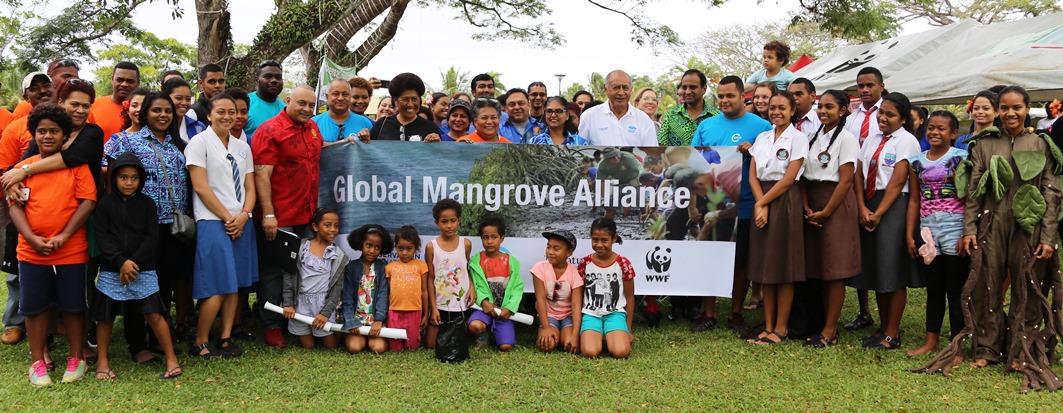Mangroves for our future
Mangrove forest ecosystems are some of the most important natural ecosystems on earth. Mangroves are now well established as effective in reducing the impacts of waves, moderating flooding and controlling erosion. Mangroves are also critical for food security providing sources of subsistence and livelihoods for the most vulnerable communities as well as cultural practices and identity.
Despite their critical importance for vulnerable coastal communities, mangroves are some of the most threatened ecosystems on Earth, approximately 1% of global coverage is lost annually. To date, 67% of mangroves have been lost or degraded worldwide and if this trend continues, all unprotected mangroves could be lost in the next 100 years.
There is a need for a coordinated action to counteract ineffective multi-sectoral threats arising from land and sea-based activities. Reversing the trend of mangrove loss and the growing vulnerability of coastal communities will require strong commitment by governments to develop and implement robust policies, good management and governance practices, and establish clear frameworks for owning, using and managing mangroves.
IUCN Mandate
Since 1975, as marked by the passing of key resolutions by the 12th General Assembly meeting in Kinshasa, Zaire, the International Union for the Conservation of Nature (IUCN) has carried the mandate to conserve critical coastal marine and related habitats, including sea grass beds, coral reefs, estuaries, and mangroves.
IUCN Members have adopted over 30 resolutions and recommendations in the subsequent decades that promote the protection, conservation, sustainable management, and restoration of coastal ecosystems globally, regionally, and in mangrove-rich nations.
IUCN will work with international members and partners to help raise global understanding and awareness of the importance and status of mangrove ecosystems, strengthen international co-operation and priority setting, and facilitate the mobilization of necessary financial resources, including through the Global Mangrove Alliance, and strengthened links to the Bonn Challenge and Blue Natural Capital Fund.
Global Mangrove Alliance
The Global Mangrove Alliance is a commitment from the international community to reverse the loss of critically important mangrove habitats worldwide. The Alliance will build upon the diverse skills and networks each organization brings to amplify existing efforts and drive increased attention to the critical role of mangroves in coastal systems. With an eye to catalysing new investments, the Alliance aims to improve land use management and on-the-ground conservation, restoration and sustainable use of mangroves. The Alliance will work locally, regionally and globally to secure commitments from governments and the private sector to halt and reverse mangrove loss. The target of the Alliance is to increase the global area of mangrove habitat 20% over current extent by the year 2030.
IUCN in the Oceania Region
IUCN developed the Pacific Mangrove Initiative (PMI), a partnership based on a collaborative platform that supports mangrove-related activities across the Pacific strengthening the conservation of mangroves, coastal zone management and the sustainability of the livelihoods of the communities that live in these areas. Partners include SPREP, USP, WWF, UNDP and governments of Fiji, Samoa, Solomon Islands, Tonga and Vanuatu.
Under the PMI, IUCN developed the Mangrove Ecosystems for Climate Change and Livelihood (MESCAL) project and the Mangrove Rehabilitation for Sustainably-Managed Healthy Forests (MARSH) Project. The primary goals of these projects were to increase resilience to climate change for the people of the Pacific Island countries through the strengthened management of mangroves through a partnership with communities, local universities, local and international NGOs, and government agencies in Fiji, Vanuatu, Solomon Islands, Samoa and Tonga.
Project activities included baseline scientific information gathering at the demonstration sites, mangrove mapping, review of governance structures both formal and informal, economic assessments, carbon sequestration studies, communication and technical training. Decision support tools have subsequently been produced to enable policy makers to make informed decisions regarding the use of mangrove resources.
With the experience gained through the implementation of the these projects and with the global experiences that IUCN has gained from other regional mangrove initiatives, IUCN Oceania Regional Office has become the de facto regional mangrove implementation partner in Oceania.



